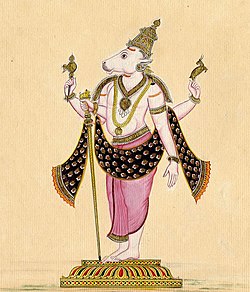Nandi (Hinduism)
Divine animal in Hinduism From Wikipedia, the free encyclopedia
Nandi (Sanskrit: नन्दि), also known as Nandikeshvara or Nandideva, is the bull vahana (mount) of the Hindu god Shiva. He is also the guardian deity of Kailash, the abode of Shiva. Almost all Shiva temples display stone images of a seated Nandi, generally facing the main shrine.
| Nandi | |
|---|---|
 Nandi in a zoo-anthropomorphic form | |
| Affiliation | Mount of Shiva |
| Abode | Mount Kailash |
| Consort | Suyasha[1] |
Etymology
The Sanskrit word nandi (Sanskrit: नन्दि) means happy, joy, and satisfaction, the properties of divine guardian of Shiva-Nandi.[2]
The application of the name Nandi to the bull (Sanskrit: Vṛṣabha) is a development of recent syncretism of different regional beliefs within Shaivism.[3] The name Nandi was widely used instead for an anthropomorphic door-keeper of Kailash, rather than his mount in the oldest Shaivite texts in Sanskrit, Tamil, and other Indian languages. Siddhanta texts distinguish between Nandi and Vṛṣabha.[4]
Legend
Summarize
Perspective
Nandi is described as the son of the sage Shilada. Shilada underwent severe penance to have a boon– a child with immortality and blessings of Shiva, and received Nandi as his son. Shiva Purana says that Nandi was born from a yajna performed by Shilada.[5] Nandi grew up as an ardent devotee of Shiva and he performed severe penance to become his gate-keeper, as well as his mount, on the banks of river Narmada. According to regional legend, this site is identified with the Tripur Tirth Kshetra in present-day Nandikeshwar Temple, in Jabalpur, Madhya Pradesh.
According to Shaiva Siddhanta, Nandi is considered to be chief among the Siddhars, initiated by Parvati and Shiva. He is regarded to have passed on what he had learned to his eight disciples, namely, the Four Kumaras, Tirumular, Vyagrapada (also known as Pullipani),[6] Patanjali, and Sivayoga Muni. They were sent out in eight different directions to spread his wisdom. His teachings are held by the Nandinatha Sampradaya, a line of gurus who claim descent from Nandi.[7][8]
Many Puranic legends are available about Nandi. One describes his conflict with Ravana, the antagonist of the Ramayana. Nandi cursed Ravana, the rakshasa king of Lanka, that his kingdom would be burnt by a forest-dweller monkey (vanara), since he behaved in a restless manner, just like a monkey, while waiting to meet Shiva. Later, Hanuman burned Lanka when he went in search of Sita, who was imprisoned by Ravana in the grove called the Ashoka Vatika.[9]
The ancient Tamil text Tiruvilaiyadal Puranam mentions another story in which Nandi is incarnated as a whale.[10] According to this legend, Parvati lost her concentration while Shiva was explaining the meaning of the Vedas to her. Parvati, then incarnated as a fisher-woman to atone for her lack of concentration. To unite his master and his beloved-wife, Nandi took the form of a whale and started to trouble the people. Parvati's father declared that the man who would kill the whale would marry his daughter. Later, Shiva took the form of a fisherman and killed the whale, and received Parvati in her previous form.[11]
The Cham Hindus of Vietnam believe that when they die, Nandi takes their soul to the holy land of India from Vietnam.
Iconography
Summarize
Perspective
The Agamas describe Nandi in a zoo-anthropomorphic form, with the head of bull and four hands, with antelope, axe, mace, and abhayamudra. In his mount form, Nandi is depicted as a seated bull in all Shiva temples, all over the world. This form has been found even in Southeast Asian countries including Cambodia.[12]
The white color of the bull symbolizes purity and justice. Symbolically, the seated Nandi faces the sanctum in Shiva temples and represents an individual jiva (soul) and the message that the jiva should always be focused on the Parameshvara. From the yogic perspective, Nandi is the mind dedicated to Shiva, the absolute. In other words, to understand and absorb light, the experience, and the wisdom is Nandi, who is the guru within.[13]
Nandi Flag

Nandi flag or Vrshabha flag, a flag with the emblem of seated bull is recognized as the flag of Shaivism, particularly among Tamil community all over the world. Nandi was the emblem of historical Tamil Shaiva monarchs, such as Pallava dynasty and Jaffna Kingdom.[16] Several campaigns to aware the Shaivas about their Nandi flag is carried out continuously during the Shivaratri session, particularly among Tamil community of Sri Lanka, Tamil Nadu, and diaspora.[17]
The Nandi flag used nowadays was designed by Ravindra Sastri of Madurai, Tamil Nadu, according to the request and guidance of S. Danapala, a Sri Lankan Shaiva personage, in the 1990s. The first Nandi flag was hoisted in 1998, at Colombo Hindu College at Ratmalana, Sri Lanka.[18][19] Following years, it was declared as the official Shaiva flag in fourth International Saiva Siddhanta Conference, held in Zurich in 2008.[15] Nowadays, Tamil Shaivas, especially in Sri Lanka, Canada, Australia, UK, South Africa, and Switzerland, hoist the flag in all religious and cultural festivals.[15][18][19] Nandi flag was declared as the official Hindu flag of Sri Lanka.[20][21]
Gallery
See also
- Kamadhenu
- Cattle in religion
- Gavaevodata, the primordial cow in Zoroastrianism
- Kao (bull)
References
External links
Wikiwand - on
Seamless Wikipedia browsing. On steroids.









